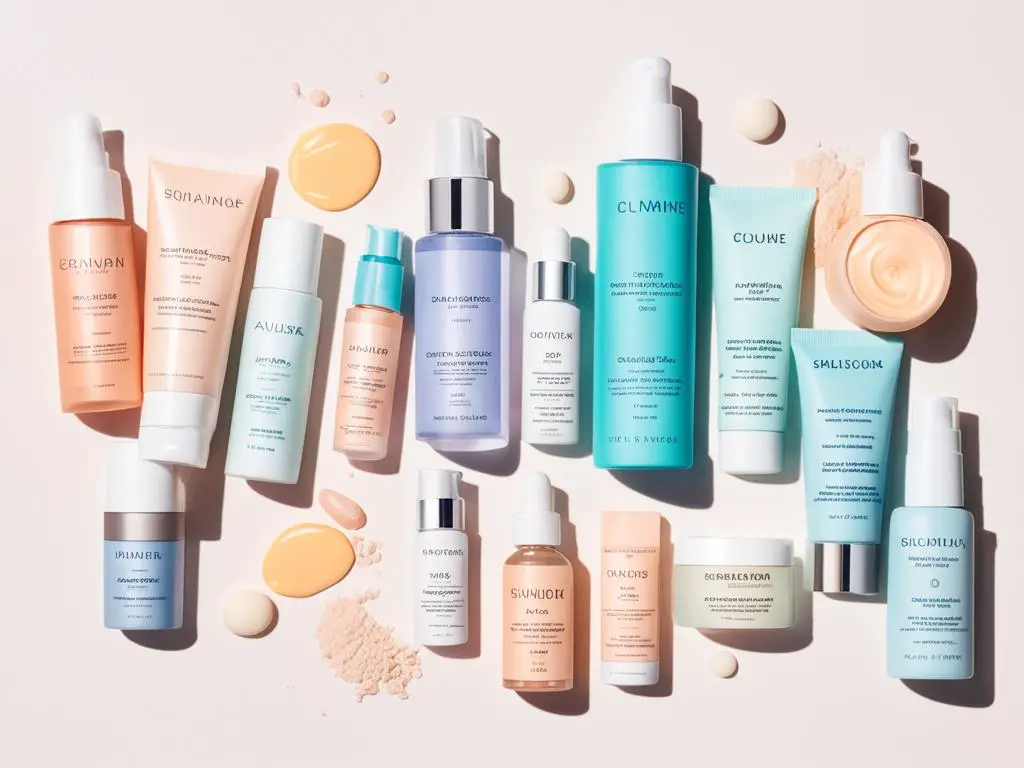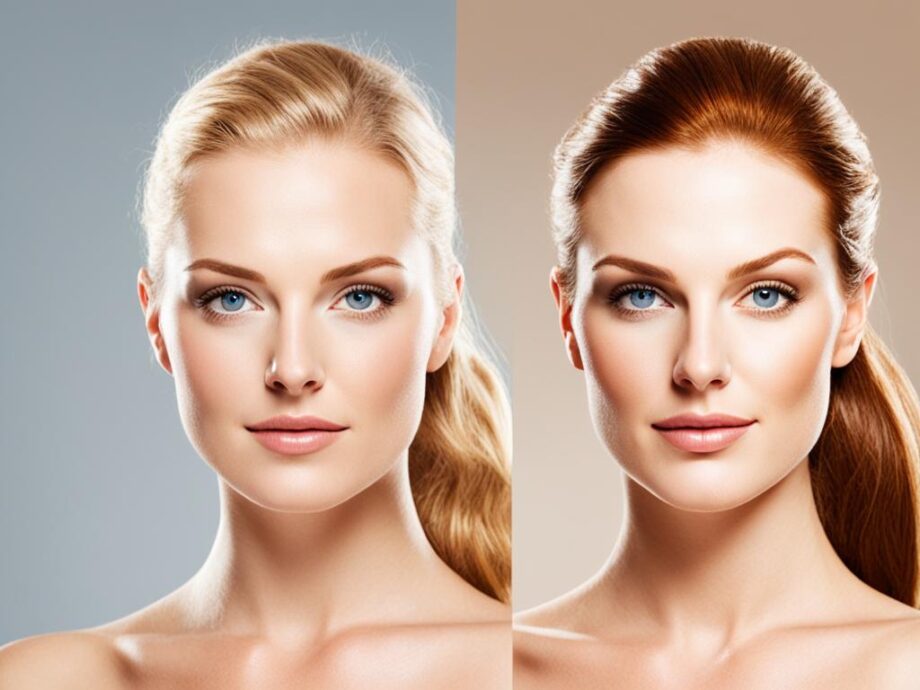Welcome to our article exploring the debate between pale and tan skin, and which option is healthier for you. When it comes to your skin, making informed choices is essential for maintaining its health and vitality. Let’s delve into the characteristics and benefits of each skin type, as well as the implications they have on your overall well-being.
Key Takeaways:
- There are advantages to both pale and tan skin, and the choice ultimately depends on personal preference.
- Maintaining the health of your skin, regardless of its tone, is crucial for overall well-being.
- Educate yourself about proper sun protection measures to avoid potential risks for both pale and tan skin.
- A personalized skincare routine is essential for addressing the specific needs of your skin type.
- Using sunscreen is important for protecting your skin from harmful UV radiation and preventing premature aging.
Understanding Pale Skin
Paleness or fair skin is often described as having a lighter complexion compared to other skin tones. While it may not be as widely celebrated in certain cultures, pale skin has its unique characteristics and benefits.
A myriad of factors contributes to paleness, including genetics, melanin production, and sun exposure. Individuals with fair skin tend to have lower levels of melanin, the pigment that gives color to the skin, hair, and eyes. This results in a lighter and paler complexion.
Having fair skin comes with its advantages in terms of skin health. Pale skin is more susceptible to sunburn, making it important to take extra precautions when it comes to sun protection. The lower melanin levels mean that fair-skinned individuals have a higher risk of developing skin damage from UV radiation. This makes it crucial for those with pale skin to use broad-spectrum sunscreen, seek shade, and wear protective clothing when they spend time outdoors.
“Fair skin is particularly prone to sunburn, which can increase the risk of skin damage and other long-term skin health issues.”
Despite the need for diligent sun protection, having pale skin has its advantages as well. Fair-skinned individuals tend to age more gracefully, thanks to their skin’s lower melanin content. They are less prone to developing hyperpigmentation and age spots, which are common concerns for those with darker skin tones.
To maintain the health of pale skin, it’s essential to establish a skincare routine that caters to its specific needs. This involves using gentle cleansers, moisturizers, and treatments that address any concerns, such as sensitivity or dryness. Regular exfoliation can help improve skin texture and enhance the natural glow of pale skin.
Embracing a Tan Complexion
Many individuals aspire to achieve a tan complexion due to its perceived attractiveness and association with a healthy outdoor lifestyle. The sun-kissed glow of a tan can enhance one’s appearance and boost self-confidence. However, it’s essential to be aware of the potential risks involved in the process.
Excessive sun exposure can lead to skin damage, including sunburn, premature aging, and an increased risk of skin cancer. Ultraviolet (UV) radiation from the sun can penetrate the skin, causing DNA damage and affecting the skin’s structure and elasticity.

To minimize the harmful effects of sun exposure and protect your skin while achieving a healthy tan, it’s crucial to follow these recommendations:
1. Limit Sun Exposure:
Avoid prolonged sun exposure during peak hours when the sun’s rays are the strongest, typically between 10 am and 4 pm. Seek shade when possible, especially if you have fair or sensitive skin.
2. Apply Sunscreen:
Before heading outdoors, generously apply a broad-spectrum sunscreen with a sun protection factor (SPF) of 30 or higher. Be sure to reapply every two hours, or more frequently if you are sweating or swimming.
3. Wear Protective Clothing:
Consider wearing lightweight, long-sleeved shirts, wide-brimmed hats, and sunglasses to provide additional protection from the sun’s harmful rays. Clothing with a high ultraviolet protection factor (UPF) can offer even greater defense.
4. Seek Alternatives:
If you’re concerned about the potential risks of tanning, consider using alternative methods to achieve a sun-kissed look. Self-tanning products, such as lotions, sprays, or mousses, can provide a safe and temporary tan without exposing your skin to harmful UV radiation.
Keep in mind that embracing a tan complexion does not justify compromising your skin’s health. Prioritize sun protection and safe tanning practices to maintain healthy and radiant skin.
By understanding the allure of a tan complexion and taking necessary precautions, you can enjoy the benefits of sun-kissed skin without compromising your overall skin health.
Health Implications of Pale vs Tan Skin
When it comes to skin color, the health implications of having pale or tan skin are worth exploring. Understanding the risks and benefits associated with each skin type can help you make informed decisions about sun protection and overall skin health.
The Risk of Skin Cancer:
Pale skin, characterized by a lack of melanin, is more susceptible to the harmful effects of sun exposure. Without the natural protection provided by melanin, individuals with fair skin have a higher risk of developing skin cancer, including melanoma, one of the deadliest forms of skin cancer.

The Role of Vitamin D:
On the other hand, having some level of tan skin offers a certain degree of natural sun protection. Melanin, the pigment responsible for skin color, acts as a shield against UV radiation, reducing the risk of sunburn and skin damage. However, it’s essential to strike a balance as excessive sun exposure can still lead to long-term skin damage and increase the risk of skin cancer.
Vitamin D, often referred to as the “sunshine vitamin,” is vital for maintaining overall health. Sun exposure triggers the production of vitamin D in the body, which is essential for healthy bones, immune function, and overall well-being. However, it is important to obtain vitamin D through safe sun exposure or dietary sources, rather than relying solely on unprotected sun exposure.
Sun Protection Tips:
To protect both pale and tan skin, it is crucial to follow effective sun protection practices:
- Apply broad-spectrum sunscreen with an SPF of 30 or higher.
- Reapply sunscreen every two hours, or more frequently if swimming or sweating.
- Seek shade during peak sun hours (10 a.m. to 4 p.m.).
- Wear protective clothing, such as hats and sunglasses, to minimize sun exposure.
Remember, maintaining healthy skin goes beyond skin tone. Regular skin checks, moisture-enhancing skincare routines, and seeking professional advice are essential for everyone, regardless of their skin color.
Skin Care Choices for Pale and Tan Skin
When it comes to taking care of your skin, having a personalized skincare routine is essential, regardless of whether you have pale or tan skin. By understanding your skin’s unique needs, you can make informed choices and cultivate a healthy complexion.
Importance of Skincare Routines
A consistent skincare routine tailored to your skin type can help address specific concerns and maintain its overall health. For pale skin, moisturizing is crucial to prevent dryness and maintain its natural radiance. Look for gentle cleansers and lightweight, non-comedogenic moisturizers. Consider incorporating a hydrating serum or facial oil into your routine to boost hydration levels. Regular exfoliation can also help to remove dead skin cells and promote a brighter complexion.
Tan skin, on the other hand, benefits from a routine that focuses on sun damage prevention and hydration. Look for skincare products with antioxidants, such as vitamin C, to combat free radicals caused by UV exposure. Incorporating a gentle exfoliant can help even out skin tone and promote cellular turnover. Don’t forget to hydrate your skin with a moisturizer suitable for your specific skin needs.
Recommended Products
When choosing skincare products, it’s essential to consider your skin type and any specific concerns you may have. Here are some recommendations for both pale and tan skin:
- For Pale Skin:
- Gentle cleanser
- Lightweight, non-comedogenic moisturizer
- Hydrating serum or facial oil
- Mild exfoliant
- For Tan Skin:
- Antioxidant-rich skincare products
- Gentle exfoliant
- Moisturizer with SPF
- Hydrating serum or facial oil
The Significance of Sunscreens
Regardless of your skin type, using sunscreen is crucial for protecting your skin from the harmful effects of the sun’s UV rays. Sunscreen helps prevent sunburn, premature aging, and reduces the risk of skin cancer.
For pale skin, choose a broad-spectrum sunscreen with a high SPF to protect against both UVA and UVB rays. Look for lightweight, non-greasy formulas that won’t clog pores. Apply sunscreen generously and reapply every two hours, especially when exposed to direct sunlight.
Tan skin also requires sun protection, although the higher melanin content does provide some natural protection against UV damage. Opt for a broad-spectrum sunscreen with a moderate SPF and reapply regularly, especially after swimming or sweating.

Conclusion
After carefully examining the debate between pale and tan skin, it is clear that both options have their own unique qualities and considerations. Pale skin often boasts a natural radiance and is less prone to certain types of skin damage. On the other hand, having a tan complexion can provide a sun-kissed glow that many find attractive.
However, it is crucial to prioritize skin health above all else. Excessive sun exposure can lead to skin damage, including sunburns, premature aging, and an increased risk of skin cancer. Regardless of your skin tone, protecting your skin from harmful UV rays should always be a top priority.
Remember, maintaining healthy skin is a personal journey, and there is no one-size-fits-all approach. It is essential to develop a skincare routine that suits your specific skin needs, whether you have pale or tan skin. Regularly moisturizing, using gentle cleansers, and incorporating sunscreen into your daily routine are habits that can benefit everyone.
In the end, the key is to embrace and care for your unique complexion, whether it is pale or tan. By making informed decisions about your skin health and care, you can ensure that your skin remains healthy, vibrant, and beautiful for years to come.
